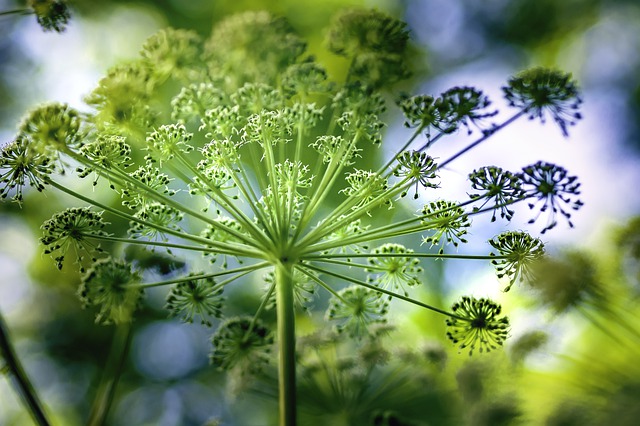 |  |  |   |  |
 |  |  |
A perennial, rarely biennial plant, which usually dies after the fruit ripens. The stem is hollow, grooved, up to 2.5 cm thick, up to 200 cm tall. The stem is covered with a gray-blue plaque, short hairy below the inflorescence, branches at the top. Leaf lobes triangular, bisected, trilobed, with long, ovate or lanceolate sharply toothed lobes. The leaves are characterized by purple bands, where the petioles of the lateral segments form. The lower leaves of the plant are on long petioles, the upper ones are sessile, with strongly inflated sheaths. Central inflorescences large, strongly curved with 15-35 short hairy rays. Flowers white or slightly pink on the outside. Fruits 4-6mm, compressed, brown. The plant blooms from early summer to late autumn. The fruits ripen in August.
For medicinal purposes, the roots of the plant are mainly used, which are dug in autumn (not earlier than September) after the fruits have ripened or in early spring. Only roots from the first year of the plant are valid for medicinal purposes. The roots are rinsed, cut finer and dried in shady, well-ventilated areas or in forced dryers at a temperature not exceeding 40C.
Plant seeds and leaves are also rarely collected. It is also common to use wild Angelica seed oil and plant juice.
The seeds are collected with all the inflorescences, dried and the seeds fall off after drying. The leaves are collected at the beginning of the flowering of the plant. They are dried in a shady and well-ventilated place.
It should be noted that the wild Angelica is collected in a place protected from the sun and dried in the same way. Under the influence of UV rays, the chemical composition of the wild Angelica changes (substances in it collapse).
The drug is stored in sealed cardboard boxes for no longer than 2 years.
Substances such as archangelin, isoimperatorin, imperatorin, xanthotoxin, scopoletin, umbelliferone and essential oils, valerian acid and tannins have been found in the plant.
The underground part of the wild Angelica contains 0.34% of essential oils, polyacetyl compounds, coumarins and other substances.
The wild Angelica is similar to its relative, the Angelica . Wild Angelica is a valuable source of vitamin C and minerals. The plant contains calcium salts (1.6%), protein (<12%), vegetable fat (7.5%), fiber (<20%). The leaves contain more than 0.9% ascorbic acid. All green parts of the plant contain 1.7mg calcium, 0.4mg phosphorus, 4.4mg manganese, 1.76mg copper, 0.55mg boron, 0.14mg titanium (per 100g).
Medicinal significance
Wild Angelica preparations have a tonic effect on the cardiovascular and central nervous system, so they are used in epilepsy, hysteria, nervous exhaustion and insomnia. The plant also has the ability to increase gastric secretion and intestinal peristalsis, it is useful for treating hypoacid gastritis, duodenitis, colitis, flatulence, bile duct dyskinesia, vegetative neurosis.
Wild Angelica , as an antispasmodic, can be used to treat arthritis, lumbago, rheumatism, radiculitis, edema and acute/chronic neuralgia. As an antitussive and expectorant agent - in case of any acute respiratory tract inflammation, as well as to get rid of bronchial asthma attacks.
The plant also contains phytoestrogens, which have a beneficial effect on the course of premenstrual syndrome.
According to folk medicine recipes, a decoction of wild Angelica roots is drunk to treat bronchitis, stomach colic, and prevent severe diarrhea. This decoction also has anti-inflammatory and diuretic properties and can be used to successfully treat oral diseases (rinsing). A decoction of the root will also act as a pain reliever, against swelling and against allergic reactions.
In folk medicine, honey collected from the wild Angelica is highly valued. This honey has a green tint and a specific aroma. Such honey contains many vitamins and minerals. It has a calming, body-strengthening, wound-healing, toning effect, as an antibacterial and antiviral agent. It successfully treats constipation, gastritis, insomnia, nervous exhaustion and ischemia.
Folk scientists tend to wild Angelica juice into the ear or at the site of tooth damage as a pain reliever.
Externally, a decoction of the wild Angelica root is used to treat neurasthenia (adding to the bath), and a decoction of the roots to be rubbed in case of gout, rheumatism and lumbar pain.
When collecting a wild Angelica , it is important to recognize it and distinguish it from other woodchucks, especially from the poisonous velnarutka, spotted dog's barrel and Sosnovsky's hogweed. These dangerous plants tend to grow in exactly the same places as wild wild Angelica .
The wild Angelica is considered an alternative to the medicinal Angelica.
